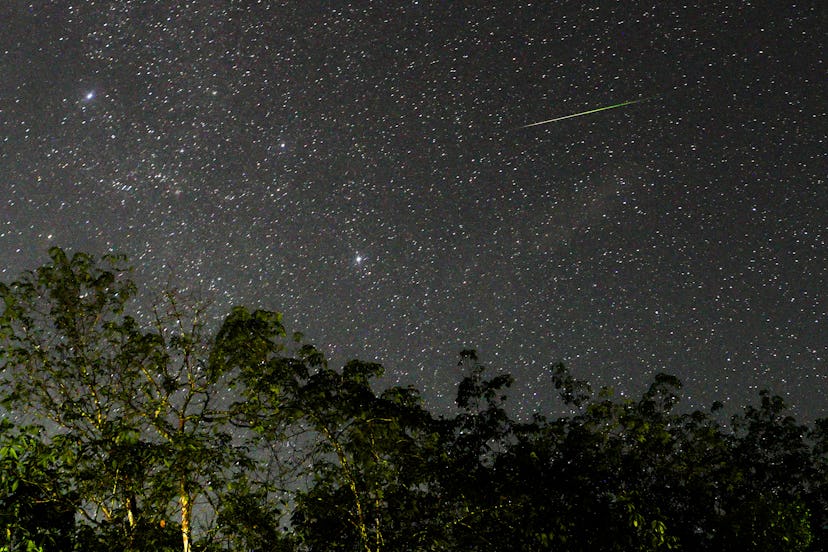2024 Kicks Off With One Of The Most Spectacular Meteor Showers Of The Year
It’s also one of the shortest.

2023 is so yesterday, and 2024 is set to kick off with a bang — one of the most popular meteor showers of the year, the Quadrantids, is set to dazzle within the first days of the new year. The elusive but staggeringly bright meteor shower is touted as a must for sky-watchers. It brings a spectacular show, but the peak only lasts a few hours.
Here's everything you need to know.
What is the Quadrantid Meteor Shower?
The Quadrantid meteor shower is one of the favorites of the year for scientists and avid sky-watchers. This meteor shower originates from an asteroid named 2003 EH1, which, according to EarthSky.org, is believed to be a dormant or extinct comet — aka a “cosmic snowball of frozen gases, rock, and dust that orbit the Sun,” the good folks at NASA explain.
At its peak, the Quadrantids can produce more than 100 meteors per hour. They’re easy to spot — they look like bright fireballs. However, the top peak time for this meteor shower is short-lived, so if you want to catch it, you'll need to plan ahead.
When will the 2024 Quadrantid Meteor Shower peak?
The Quadrantid meteor shower runs from mid-November through mid-January each year and is one of the favorite meteor showers of the year, joining the Lyrids, Leonids, and Ursids, which are also "sharp peak" sky shows, EarthSky.org explains.
But although the shower happens over a few weeks, the best night to catch the 2024 Quadrantids is January 3-4, with the predicted peak in the early hours of January 4, per EarthSky.org.
"A bright last quarter moon will rise around midnight and shine the rest of the night," the site explains. "Try late night January 3 to dawn January 4, in moonlight."
To find the most accurate estimate for the exact time when the Quadrantid meteor shower will peak where you live, check out the chart on TimeandDate.com.
What are the best conditions to watch the 2024 Quadrantid Meteor Shower?
According to the experts, the best conditions to watch any meteor shower, including the Quadrantids, requires a few things to line up. You'll want to make sure your viewing spot has minimal light pollution from the city lights or even a bright moon. Traveling to an ideal location is simple for some who only need to drive a short distance, but others might need to make more solid arrangements to visit a park with little light — like an official dark sky location.
You’ll also want to make sure you get set up early so your eyes adjust to the darker conditions.
You don't need any special equipment like a telescope to view the Quadrantids, though using one can make the show more exciting. Also, it's important to remember that with the shower happening in early January, you'll want to make sure you and the kids are bundled up and ready to spend some time in the cold.
Which dark sky parks will have the best view of the Quadrantid Meteor Shower?
The biggest obstacle to seeing any nighttime sky show is light pollution, which lights up the sky with artificial light, making it a real challenge to see meteor showers and enjoy general nighttime star viewing.
Thankfully, getting away from the city and driving into less urban, more open spaces where few city lights or buildings obstruct the view can give you better conditions to catch the show.
Viewing will be even better if you and the family head to a "dark sky park," where you'll have an unobstructed view of the 2024 Quadrantid meteor shower.
The International Dark-Sky Association (IDA) is a non-profit that tracks and records locations across the country that are considered "dark sky parks," or areas where there is very little light pollution. These are the best locations to view nighttime meteor showers like the 2024 Quadrantids.
According to the IDA, there are loads of locations across the country certified as "dark sky parks," including several national parks, which is a great reason to go on a road trip with the kids. Here are a few to consider:
- The Appalachian Mountain Club's (AMC) Maine Woods in Maine
- Cape Lookout National Seashore in North Carolina
- Canyonlands National Park in Utah
- Big Bend Ranch State Park in Texas
- Cherry Springs State Park in Pennsylvania
- Newport State Park in Wisconsin
- Kissimmee Prairie Preserve State Park in Florida
For a complete list of IDA-certified National Parks and other designated "dark sky parks" to help plan your star gazing event, visit the IDA's website.
This article was originally published on